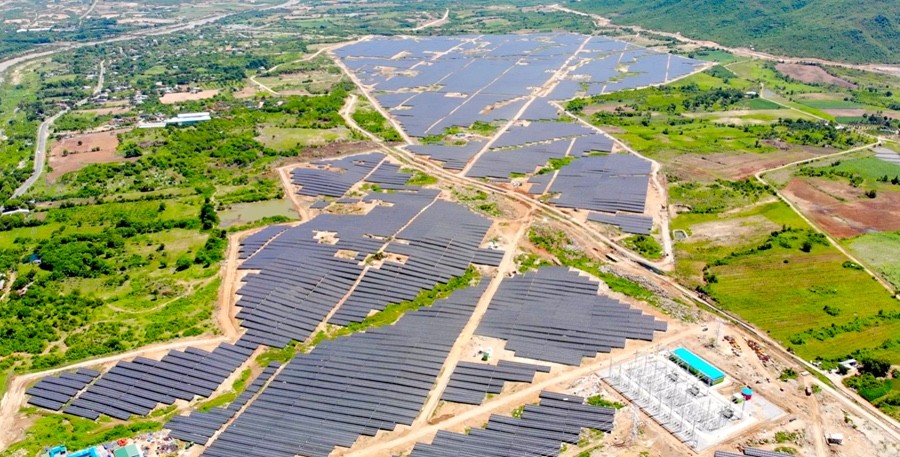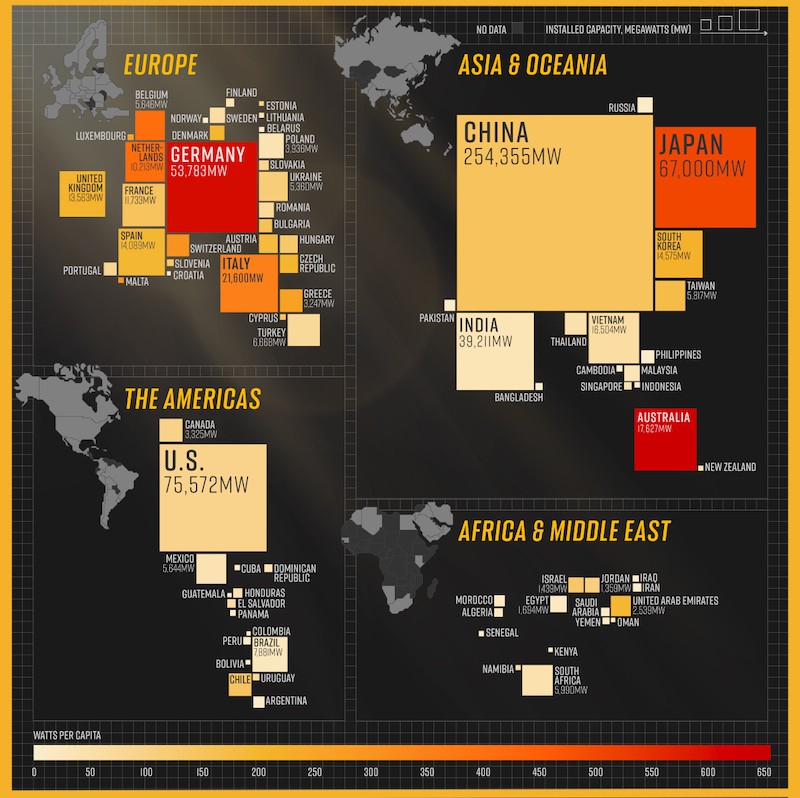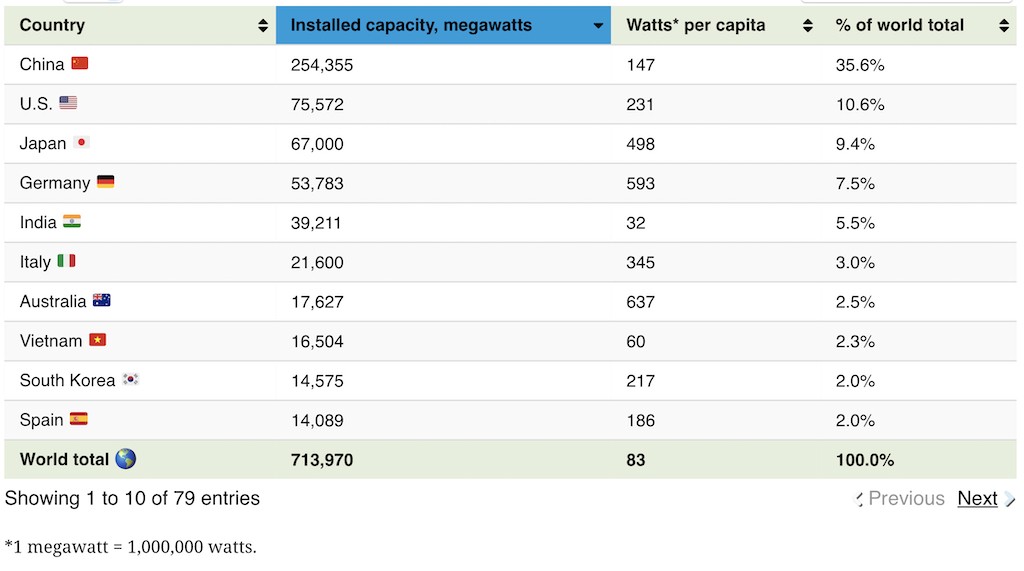Vietnam Ranks 4th in Solar Energy Capacity Among Asia Countries
Global renewable energy capacity additions in 2020 reflect unprecedented momentum for the energy transition. Despite the COVID-19 induced economic slowdown, the world added more than 260 gigawatts (GW) of renewables last year, exceeding expansion in 2019 by close to 50%, the International Renewable Energy Agency (IRENA) reported.
In Renewable capacity statistics 2021 report, IRENA provided the solar power capacity of the world of 2020. This includes both solar photovoltaic (PV) and concentrated solar power capacity. Other categories are: hydropower, wind energy, bioenergy, geothermal energy and off-grid electricity (stand-alone electricity).
Vietnam grows in renewable energy capacity
 |
| Part of solar panel system in Ninh Thuan, Vietnam. Photo: Nang Luong Sach Viet Nam |
The main findings of the report indicate that Vietnam ranks 4th in Asia for the amount of installed solar power nationwide behind China (254,355 MW), Japan (67,000 MW), and India (39,211 MW).
In total renewable energy capacity, Vietnam ranks 6th in the continent with 335,990 MW in 2020. With the 2011 capacity of 172,518 MW, we had doubled the amount compared to 10 years ago.
This suggests that Vietnam is adopting renewable energy at an unprecedented pace, and solar power is the energy source leading the way. In 2019, the capacity of the whole nation was only 4,898 MW.
 |
| Mapped: Solar power by country in 2021. Photo: Visual Capitalist |
The solar power leaderboard
According to Visual Capitalist, countries in every continent (except Antarctica) added more solar to their mix last year. Here’s a snapshot of solar power capacity by country at the beginning of 2021.
Vietnam ranked 8th in the list of 79 countries, with the capacity of installed solar power nationwide reaching 16,504 MW, accounting for 2.3% of global capacity. Hence, its solar power capacity reached 60 W per capita.
 |
| Vietnam ranks 8th place in the list of top 10 countries with largest installed solar power capacity. Photo: Visual Capitalist |
China remains as the undisputed leader in terms of solar installations, with 35.6% of global capacity. China installed 49,355MW of new solar capacity in 2020, and solar installations in 2021 are expected to reach 55,000-65,000MW.
Following behind China is the United States, which reached 75,572 MW of solar power capacity, making up 10.6%.
The remaining countries among the top 10 include Japan with 9.4%, Germany with 7.5%, India with 5.5%, Australia with 2.5%, the Republic of Korea with 2%, and Spain with 2%.
The cheapest source of new energy generation
What's driving the rush of solar power is how cheap it has become over time. Solar energy costs have dropped significantly over the last decade.
Since 2010, the cost of solar power has seen a 85% decrease, down from US$0.28 to US$0.04 per kWh. As the world installed and made more solar panels, production became cheaper and more efficient.
This makes economies of scale the single-largest factor in continuing the cost decline for the last decade. Countries can now invest in this renewable energy generation much easier compared to 10 years ago.
In 2021, however, solar costs are rising due to supply chain issues. Experts believe the rise is likely to be temporary, and the affordable trend of new energy will continue in the next decade.
This good new comes as we grapple with the most effective way to rebuild our economies while pursuing the medium and long-term goals of the SDGs and the Paris Agreement.
Highlights of Solar Power by Country in 2021Here are some fun facts about the major components in leading solar energy capacity countries in 2020, presented by IRENA: • India’s Bhadla solar park is the largest in the world with a capacity of 2,245MW. • Australia has the highest solar radiation per square meter of any continent and leads the per capita capacity rankings • Germany’s solar power capacity is more than twice that of any other European country. • China has the world’s largest wind and solar project in the pipeline, which could add a further 400,000MW to its overall clean energy capacity. |
 | Vietnam's English Skills Dropped to Low Proficiency in Global Index Vietnam continues to rank in the low band for English proficiency, landed at 66th in the Global English Proficiency Index. |
 | Vietnam Ranked 6th in Countries with Highest Number of Students Studying in US This year marked the second continuous year the number of Vietnamese students studying in the US decreased due to the impacts of the pandemic. |
 | Vietnam Ranked Third in ASEAN for Fintech Funding Fintech funding in 6 ASEAN countries tripled to US$4.7 billion in the first three quarters of 2021. |
Recommended
 Viet's Home
Viet's Home
Can Tho Awards 500 Scholarships to Workers’ Children
 Viet's Home
Viet's Home
Traditional Martial Arts Exchange between Sinh village (Hue City) and Katsuragi City (Japan)
 Viet's Home
Viet's Home
Lai Chau National Assembly, People's Council Delegates Hold Dialogue with Children
 Viet's Home
Viet's Home
24 Children with Disabilities in Northern Provinces Received Free Surgery
Popular article
 Viet's Home
Viet's Home
World Vision Promotes Comprehensive Nutritional Care for Vietnamese Children
 Viet's Home
Viet's Home
Hanoi, South Africa Strengthens People-to-people Exchanges, Expands Multi-sector Cooperation
 Viet's Home
Viet's Home
Hue City to Raise Awareness on Mine Accident Prevention
 Focus
Focus







